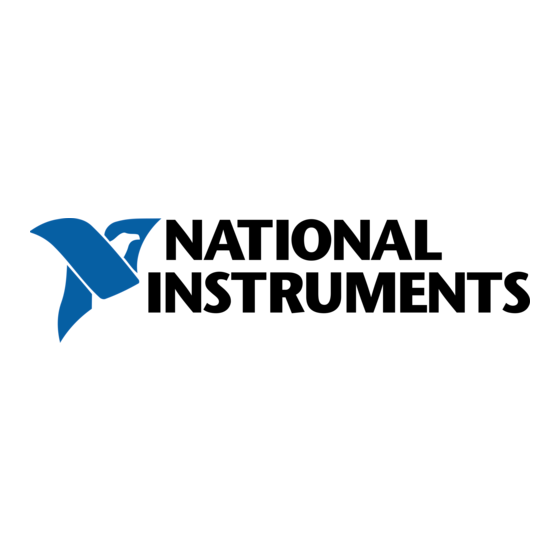

National Instruments SCC-RTD01 User Manual
Resistance temperature detector
Hide thumbs
Also See for SCC-RTD01:
- User manual (15 pages) ,
- Quick start manual (36 pages) ,
- User manual (15 pages)
Table of Contents
Advertisement
Quick Links
USER GUIDE
SCC-RTD01 Resistance
Temperature Detector
Conventions
»
The SCC-RTD01 resistance temperature detector (RTD) input module
accepts up to two RTD input signals from 2-, 3-, or 4-wire RTDs. Each
module consists of two RTD input channels, a 30 Hz Butterworth lowpass
filter for each channel, and a 1 mA excitation current source. Each input
channel includes an instrumentation amplifier with differential inputs and
a fixed gain of 25.
The SCC-RTD01 filters RTD inputs and passes them through a differential
amplifier with a fixed gain of 25 resulting in a maximum input voltage of
400 mVDC. The output of the amplifier passes through a three-pole, 30 Hz
Butterworth lowpass filter. The SCC-RTD01 provides a 1 mA excitation
current source for RTDs.
The following conventions are used in this guide:
The » symbol leads you through nested menu items and dialog box options
to a final action. The sequence File»Page Setup»Options directs you to
pull down the File menu, select the Page Setup item, and select Options
from the last dialog box.
This icon denotes a note, which alerts you to important information.
This icon denotes a caution, which advises you of precautions to take
to avoid injury, data loss, or a system crash. When this symbol is marked
on the product, refer to the Read Me First: Safety and Radio-Frequency
Interference document, shipped with the product, for precautions to take.
When symbol is marked on a product, it denotes a warning advising you to
take precautions to avoid electrical shock.
When symbol is marked on a product, it denotes a component that may be
hot. Touching this component may result in bodily injury.
Advertisement
Table of Contents

Summary of Contents for National Instruments SCC-RTD01
- Page 1 25. The SCC-RTD01 filters RTD inputs and passes them through a differential amplifier with a fixed gain of 25 resulting in a maximum input voltage of 400 mVDC. The output of the amplifier passes through a three-pole, 30 Hz Butterworth lowpass filter.
-
Page 2: What You Need To Get Started
SC-2345 refers to both the SC-2345 connector block and the SC-2345 with configurable connectors. SCC refers to any SCC Series signal conditioning module. What You Need to Get Started To set up and use the SCC-RTD01, you need the following items: ❑ Hardware –... -
Page 3: Device Specific Information
You can plug the SCC-RTD01 into any AI socket on the SCC. The SCC-RTD01 can function as a single-stage module or as the first stage of a dual-stage signal conditioning configuration. The socket you choose determines which E/M Series DAQ device channels receive the SCC-RTD01 signals, as explained in the SCC Quick Start Guide. -
Page 4: Connecting The Input Signals
E/M Series DAQ device channel X+8, and pins 3 and 4 form a second differential channel routed to E/M Series DAQ device channel X, where X is 0 to 7 depending on the socket of the SCC-RTD01. Pins 5 and 6 carry the 1 mA constant-current excitation source. - Page 5 3-Wire, 1 Channel, Remote Sensing SCC-RTD01 (1 mA) – E/M Series AI ( X ) – Black E/M Series – AI ( X +8) 2-Wire, 1 Channel Figure 1. SCC-RTD01 Single-Channel Wiring Diagrams © National Instruments Corporation SCC-RTD01 Resistance Temperature Detector User Guide...
- Page 6 Use 4-wire transducer connections for a more accurate measurement. Lead resistance in 2- and 3-wire connections can introduce measurement errors. For information about configuring the SCC-RTD01 module using NI-DAQmx, refer to the SCC Quick Start Guide. SCC-RTD01 Resistance Temperature Detector User Guide...
- Page 7 Explorer (MAX), Read Voltage Data and scale it in your ADE. Converting Voltage Measurements to Temperature Measurements If you use MAX to configure the SCC-RTD01, the reading you get from the E/M Series DAQ device is properly scaled. Otherwise, you must scale...
- Page 8 Most platinum RTD curves conform to one of the following three standardized curves: • DIN 43760 standard • U.S. Industrial or American standard • International Temperature Scale (ITS)–90 (for use with wire-wound RTDs) SCC-RTD01 Resistance Temperature Detector User Guide ni.com...
-
Page 9: Specifications
Recommended warm-up time ....5 min Amplifier Characteristics Common-mode rejection ratio ....110 dB at 60 Hz Output range........... ±10 V Calculated relative to the input range of the module. © National Instruments Corporation SCC-RTD01 Resistance Temperature Detector User Guide... -
Page 10: Power Requirement
(0.74 in.) 7.93 cm (3.12 in.) 3.55 cm (1.4 in.) Figure 3. SCC-RTD01 Dimensions Weight ............24 g (0.8 oz) I/O connectors.........20-pin right-angle male connector, 6-pin screw terminal Field-wiring diameter ......28 to 16 AWG SCC-RTD01 Resistance Temperature Detector User Guide ni.com... -
Page 11: Electromagnetic Compatibility
• EN 55011 Emissions; Group 1, Class A • CE, C-Tick, ICES, and FCC Part 15 Emissions; Class A For EMC compliance, operate this device according to product documentation. Note © National Instruments Corporation SCC-RTD01 Resistance Temperature Detector User Guide... -
Page 12: Waste Electrical And Electronic Equipment (Weee)
Waste Electrical and Electronic Equipment (WEEE) At the end of their life cycle, all products must be sent to a WEEE recycling EU Customers center. For more information about WEEE recycling centers and National Instruments WEEE initiatives, visit ni.com/environment/weee.htm I/O Connector Pin Assignments Figure 4 shows the I/O connector pins on the bottom of the module. - Page 13 Instruments trademarks. Other product and company names mentioned herein are trademarks or trade names of their respective companies. For patents covering National Instruments products, refer to the appropriate location: Help»Patents in your software, the patents.txt file on your CD, or ni.com/patents.


Need help?
Do you have a question about the SCC-RTD01 and is the answer not in the manual?
Questions and answers